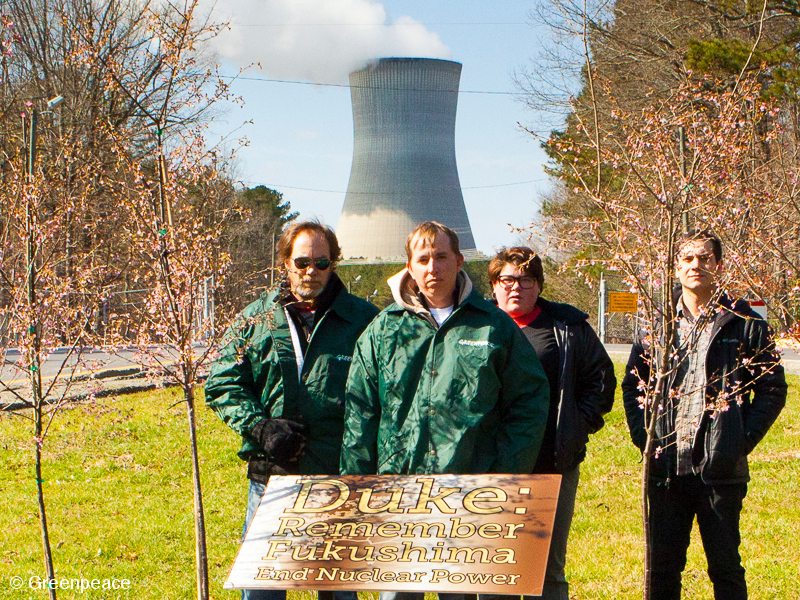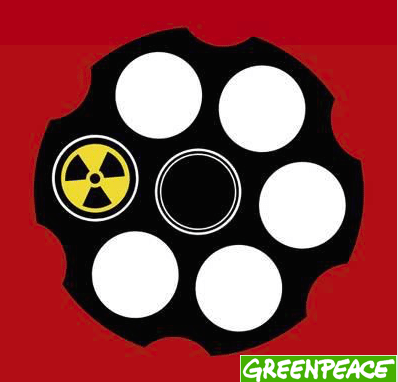Thirty years after Chernobyl and five years after the triple meltdown at Fukushima Daiichi in Japan, U.S. nuclear regulators are claiming that U.S. nuclear power plants are safe and that Fukushima couldn’t happen here. The updated Nuclear Near Misses report reveals that nothing could be further from the truth.

Greenpeace has documented 166 near misses or accident precursors at U.S. nuclear power plants. Sixty one events and more than one hundred conditions were identified by the U.S. Nuclear Regulatory Commission’s (NRC) risk analysts over the last decade that could have lead to a meltdown. Ten of these near misses are considered important precursors to a melt down.
Click here to download the full report.
Unfortunately, NRC’s Accident Sequence Precursor program missed three of the most risk significant near misses in the past decade; the triple meltdown threat to Duke Energy’s Oconee Nuclear Station in South Carolina. According to NRC’s risk analysts, if Jocassee Dam failed all three of the nuclear reactors at Oconee were certain to meltdown. And contrary to the claims of the Nuclear Regulatory Commission, the threat to Oconee’s three reactors was hundreds of times more probable than the tsunami that struck Japan in 2011.
 But the reactors at Duke Energy’s Oconee nuclear plant weren’t the only ones threatened by flooding over the past decade. The NRC has documented over a dozen other nuclear reactors that were also threatened. Many of these near miss vulnerabilities dated back decades and were only identified after the NRC was forced to take a closer look in the aftermath of Fukushima. In addition to the flooding vulnerabilities, NRC risk analysts identified a statistically significant trend in Losses of Offsite Power or (LOOPs) at US nuclear plants due to 20 events in the last four years.
But the reactors at Duke Energy’s Oconee nuclear plant weren’t the only ones threatened by flooding over the past decade. The NRC has documented over a dozen other nuclear reactors that were also threatened. Many of these near miss vulnerabilities dated back decades and were only identified after the NRC was forced to take a closer look in the aftermath of Fukushima. In addition to the flooding vulnerabilities, NRC risk analysts identified a statistically significant trend in Losses of Offsite Power or (LOOPs) at US nuclear plants due to 20 events in the last four years.
As disturbing as the 166 near misses is the fact that NRC staff has had to turn whistleblower and go public on four of the top ten near misses in order to get the agency to address the risks in a timely manner.
Contrary to NRC commissioners’ claims, there is nothing safe about the nuclear reactors in the United States. It is clear that these kinds of disasters could absolutely happen here. It is time for the NRC to listen to the whistleblowers within its own ranks and address these longstanding issues and vulnerabilities.
The NRC’s failure to make public the documents that revealed the flooding threat to all three reactors at Duke Energy’s Oconee Nuclear Station has only served to significantly delay the final resolution of nuclear near misses that are even more risk significant than those that caused the fiasco at Fukushima. The NRC’s failure to address long standing safety issues at Oconee and other US nuclear plants further serves to undermine public confidence in nuclear power and those that regulate it.
If the NRC can’t even accurately track near meltdowns why should the public have any confidence that they can prevent them? It’s time to retire these dangerous nuclear plants and end the nuclear era once and for all.
Greenpeace US’ report on Nuclear Near Misses finds that despite years of inspections, licensing and re-licensing, safety issues continue to be identified at US reactors; many of which date back decades. These long standing vulnerabilities make nuclear power anything but safe.
The Greenpeace report can be found here.
